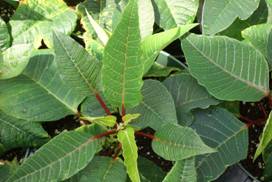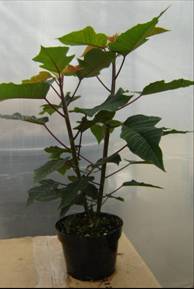8/24/2011
The Effects of Heat Stress During Poinsettia Production
Rebecca Siemonsma
With temperatures as high as they have ever been in many areas of the country many poinsettia growers have been challenged to manage greenhouse environments accordingly, minimizing stress to their poinsettias. We have already discussed different strategies to reduce the risk of heat stress to poinsettias in propagation and in establishing rooted cuttings. Now let’s take a look at the many ways heat can actually have an impact on all stages of poinsettia production. In many cases the effects of high heat may not be apparent immediately, but rather weeks after the extreme heat has subsided.
Heat stress’s effects on rooting:
- High greenhouse temperatures can equal hot media temperatures. When the media is too hot it can actually cook young poinsettia roots. Damaged roots from heat stress are more susceptible to root rotting pathogens such as Pythium. Shading the greenhouse and syringing with cool, clear water during the hottest part of the day will help cool the media.
- Excessive watering during periods of high heat will lead to poor root growth. When luxury amounts are nutrients and water are continually available there is no need for poinsettias to expend a lot of energy maintaining an extensive root system.
- Poinsettias are more susceptible to Rhizoctonia when heat stressed. This fungus is spread by water and is usually an issue during poinsettia propagation and on newly transplanted cuttings. Rhizoctonia stem rot causes a canker at the soil line but it can also travel to the roots and diseased plants will either die or growth will be stunted. During extreme heat conditions if Rhizoctonia is a concern a preventative fungicide drench is a good idea.
Root growth can actually be inhibited if plants are under extreme heat stress. Without a healthy, established root system vegetative growth will be compromised.
Heat stress’s effects on vegetative growth:
 |
| Strap-like leaves can result from heat stress. |
- Leaf distortion is common when poinsettias are heat stressed. Symptoms are extremely variable and certain cultivars tend to be more sensitive to distortion. Damage begins when leaves are extremely young. Cells can be physically damaged or rupture if plants have been allowed to wilt or actual leaf temperatures are high. As a leaf with damaged cells expands distortion is apparent. This is most often observed after pinch as new branches and leaves begin to grow. Dramatic changes in environment, especially temperature, often contribute to distortion and for this reason proper acclimation to higher light and higher heat is important.
- Enations are ruffled leaf tissue that appears on the interveinal leaf tissue on the underside of the leaf. Enations are usually the result of airflow across the leaf surface during periods of high heat.
- Excessive watering during periods of high heat can lead to soft, stretchy vegetative growth and weak stems. More shade is also needed to control greenhouse temperatures which can also contribute to weak growth. Weak vegetative growth will likely result in stem breakage later in production. During periods of high heat additional growth regulating may be necessary to tone growth.
 |
| Heat stress can cause leaf distortion. |
- In extended periods of extreme heat stress blind shoots can also occur. Blind shoots may appear blackened or completely absent of a leaf axil. Most commercial cultivars today are not susceptible to blind shoots unless extreme heat and stress conditions are ongoing.
Heat stress’s effects of branching:
- Environmental stress during propagation, establishment, and vegetative growth phases can have an impact on branching. High light levels, excessive temperatures, and reduced relative humidity can reduce the number of shoots formed after pinch.
- During periods of extreme heat and low relatively humidity poinsettia tissue can harden, compromising branching.
- Loss of phytoplasma (MLO) can result with extended, extreme heat. Phytoplasma are organisms present in the phloem of the poinsettia plant. Phytoplasma reacts with a poinsettias genome and this reaction initiates a hormone responsible for “free branching”. Heat stress conditions (high light, high heat, low moisture availability) during propagation and the establishing phase can actually eliminate phytoplasm resulting in poor branching, uneven branch development, and a physical appearance not characteristic of a particular cultivar. All poinsettia cultivars can lose phytoplasma but some cultivars appear to be more susceptible.
 |
| Example of phytoplasma loss. |
Specific data showing what temperatures and the duration of those temperatures needed to actually remove phytoplasm are not available at this time. However, initial trialing by the Ecke Ranch suggests that at under trial conditions of maximum day temperatures of a 100˚F/37˚C or more and night temperatures of not less than 70˚F/21˚C, the phytoplasm was removed from 10%-20% of the plants after 1 to 2 weeks of treatment at those temperatures. These high temperature treatments were effective in removing the phytoplasm in some plants from propagation through 1 to 2 weeks after pinch. . It is also likely that there is an interaction between humidity and temperature and it’s affect on loss of the phytoplasma, but tests were not conducted to establish the link between the two.
Take necessary steps to manage the greenhouse environment properly and alleviate the stresses heat can cause. Heat stress can diminish the quality of a poinsettia crop at any stage of production.
- Mist young plants with clear water in the warmest part of the day. This will help cool the leaf surface.
- Syringe plants with clear, cool water to cool root systems or consider adjusting watering schedule to irrigate plants in the afternoon rather than first thing in the morning. An afternoon irrigation will cool the plants without the risk of over saturating the media which could be the case if the plants are watered in the morning then syringed again if the afternoon.
- Wet walk ways to allow evaporation to cool the greenhouse and raise the relative humidity.
I
f you have further questions or concerns you can post those questions in On Board at www.EckeRanchTechHelp.com or email Rebecca Siemonsma at rsiemonsma@eckeranch.com. She can also be reached at 760.944.4060